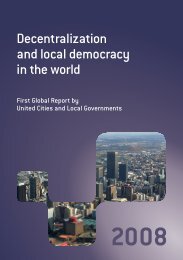Making Cities Resilient Report 2012
Making Cities Resilient Report 2012
Making Cities Resilient Report 2012
You also want an ePaper? Increase the reach of your titles
YUMPU automatically turns print PDFs into web optimized ePapers that Google loves.
Several cities report that they have integrated hazard risk information into their urban planning processes.<br />
After an initial risk assessment in Bhubaneswar in 2003, the city updated its master plan and revisited its<br />
building bylaws to account for hazard risks (16). Quito is developing risk-sensitive land use planning (22).<br />
Makati City and Makassar 12 have updated their land use planning processes so that development in a<br />
hazard -prone or environmentally-sensitive area requires an environmental compliance certificate.<br />
Urban plans and disaster risk management plans in Cairns are linked to codes that offer specific guidance<br />
to regulate development in areas prone to landslides, bushfires and flooding. (46)<br />
Albay Province has supported 18 municipalities to prepare comprehensive land use plans that address<br />
climate and disaster risks and integrate these risks into provincial plans. This has been institutionalised<br />
through a special planning ordinance and an updated provincial Comprehensive Land Use Plan (CLUP) for<br />
disaster risk reduction and climate change adaptation and mitigation (45).<br />
Colombo has taken several planning and development actions to minimize unplanned urban development,<br />
prevent unauthorized construction and discourage investments in areas that are environmentally sensitive<br />
and risk-prone (17).<br />
In the SAMEN programme of Mashhad, Iran, a pilot risk reduction project is underway with support from<br />
the provincial government. Thirty sub-projects are addressing the Ten Essentials, including risk mapping,<br />
modelling earthquake scenarios, establishing emergency response teams, community-based disaster<br />
risk management and land use planning (61).<br />
Building codes and enforcement<br />
Several cities report that building codes take into account the risk of hazards. However, most cities report<br />
difficulties in enforcing and achieving compliance with the codes. Sometimes there is insufficient staff to<br />
enforce the codes; in other cases, legislation is weak. In Makassar, while building permits are intended to<br />
comply with building codes and environmental considerations, often they are issued without complete<br />
compliance. When the city applied the HFA local self-assessment tool, they noted that legislation must be<br />
strengthened. In Narok, Kisumu and Moshi, local councils have put codes and regulations in place, but all<br />
struggle to enforce them. (40).<br />
Thimphu has strict design requirements for particular hazards: for earthquake risk; density and land<br />
coverage for landslide risk; and wind load standards for cyclone risk (42). Although the city conducts<br />
annual inspections of buildings and facilities to review compliance with the national building code (31), it<br />
has reported difficulties arising from its limited expertise and capacity to monitor construction and from<br />
citizens who complain about higher construction costs associated with the need to comply with antiseismic<br />
standards and regulations that limit buildings to 20 per cent of plot coverage (42).<br />
Bhubaneswar has taken another approach to improve compliance with seismic building codes by focusing<br />
on training engineers, architects and planners (and in some cases, masons) to use Rapid Visual Screening<br />
(see more in Box 4.9) to assess the built environment’s capacity to resist earthquakes and on earthquake<br />
engineering principles and multi-hazard construction technologies (32). The city has also updated its<br />
building codes based on the recent risk assessments (16).<br />
Relocation<br />
Some cities have relocation programmes to move people living in precarious informal settlements to safer<br />
sites. In Guicadale in Albay Province, the disaster risk reduction strategy centres on relocating businesses<br />
12. This was prompted by the devastating landslides in 2004 and hazard, risk and vulnerability are now included in land use plans. All projects<br />
that may impact the natural environment, including natural hazards, must have an environmental impact assessment and must be granted an<br />
environmental compliance certificate before they can go ahead.<br />
54 | <strong>Making</strong> <strong>Cities</strong> <strong>Resilient</strong> <strong>Report</strong> <strong>2012</strong>

















